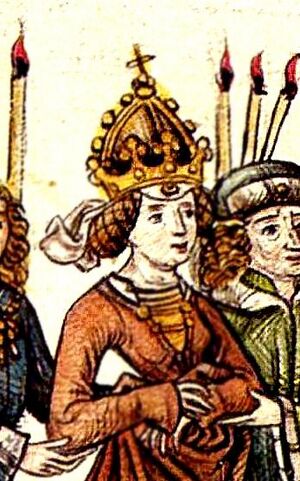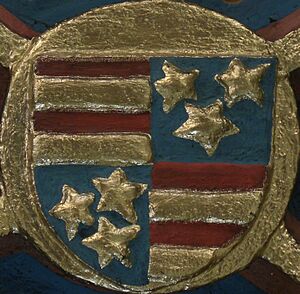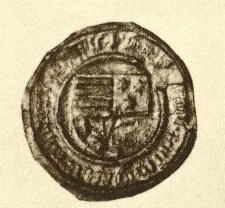Barbara of Cilli facts for kids
Quick facts for kids Barbara |
|
|---|---|
 |
|
| Queen consort of Hungary | |
| Tenure | 1405–1437 |
| Coronation | 1408 |
| Queen consort of the Romans | |
| Tenure | 1411–1437 |
| Coronation | 1414 |
| Queen consort of Bohemia | |
| Tenure | 1419–1437 |
| Coronation | 1437 |
| Holy Roman Empress | |
| Tenure | 1433–1437 |
| Coronation | 1433 |
| Born | 1392 Celje, County of Cilli (now Slovenia) |
| Died | 11 July 1451 Mělník, Bohemia, Crown of Bohemia (now Czech Republic) |
| Spouse | Sigismund, Holy Roman Emperor |
| Issue | Elizabeth of Luxembourg |
| House | House of Cilli |
| Father | Herman II, Count of Celje |
| Mother | Countess Anna of Schaunberg |
Barbara of Cilli (also known as Barbara of Celje) was a powerful queen and empress in the 1400s. She was born in 1392 and passed away on July 11, 1451. Through her marriage to Holy Roman Emperor Sigismund, she became the Holy Roman Empress and the Queen of Hungary and Bohemia.
Barbara was very active in the politics and economy of her time. She managed large areas of land and collected taxes on her own. She also played a key role in creating a famous royal group called the Order of the Dragon. She even served as the temporary ruler (regent) of Hungary four times when her husband was away. These times were in 1412, 1414, 1416, and 1418.
Barbara's Life
Barbara was born in Celje, which is now part of Slovenia. She was the youngest child of Herman II, Count of Celje, and Countess Anna of Schaunberg.
In 1405, Barbara became engaged to Sigismund of Bohemia. He was the King of Hungary and the youngest son of Charles IV, Holy Roman Emperor. Their marriage likely took place in December 1405.
Becoming Queen and Empress
As her husband Sigismund gained more power, Barbara also received important titles. He became ruler of Germany in 1410 and Bohemia in 1419. When Sigismund was crowned Holy Roman Emperor in 1433, Barbara became Holy Roman Empress.
Barbara spent most of her time managing her lands in Hungary. Her husband, Sigismund, was often busy with other matters. She was the regent of Hungary during his absences in 1412, 1414, 1416, and 1418.
She was crowned Queen of Hungary in 1408. She became Queen of Germany in 1414, which was the last time a queen was crowned in Aachen. In 1433, she was crowned Holy Roman Empress, and in 1437, Queen of Bohemia. This was just before her husband passed away.
In 1409, Barbara gave birth to a daughter named Elizabeth of Luxembourg. Elizabeth was Sigismund's only child who survived and became his heir. She later married King Albert II of Germany.
Barbara was known for being very wealthy, even richer than many queens before her. In 1409, she was given control of lands that once belonged to the Ban of Slavonia.
At one point, Barbara faced a difficult period. In 1419, she lost many of her possessions and was sent away to Oradea. However, her young daughter Elizabeth helped arrange a reconciliation. By 1423, Barbara was allowed to have her own court again. In 1424, her husband gave her many new lands and income sources. These included the counties of Zvolen and Trenčín, and money from the mines in Kremnica.
A Strong Leader
Barbara was an energetic regent and even acted as a military leader when Hungary was attacked. In 1431, Hungary was attacked twice by Hussite forces. During the second attack, they even entered Barbara's own lands.
Barbara quickly took action. She organized defenses and planned to take back a castle that had been captured. She sent letters to cities, asking for soldiers, crossbows, arrows, and gunpowder. Her army, led by Stefan Poharnok, worked to recapture the castle. Barbara's quick actions likely helped push the Hussites out of her lands.
Barbara had a complex relationship with the Hussites. At first, she strongly spoke out against them. But later, she seemed to support one of their leaders, George Podiebrad.
We know a lot about Barbara's work because about 250 official documents (charters) issued in her name still exist today. These documents were created between 1406 and 1438.
Barbara was also good at getting help from other parts of Europe. She corresponded with Vienna and the Teutonic Order to get experts for building her fortresses. This showed her skill in managing her properties and using resources from different regions. She also traveled with Sigismund to important meetings in cities like Breslau, Nuremberg, and Pressburg.
At the Council of Constance in 1414, Barbara took on her role as the first lady of Europe. She performed many important ceremonial duties. Many people at the time remembered her as a young, lively, and beautiful queen.
Founding the Order of the Dragon
On December 12, 1408, Barbara and Sigismund, along with twenty-two important barons, created the Order of the Dragon. Barbara was a co-founder, appearing as an equal partner to Sigismund.
The main goals of the Order were to support the royal couple, increase the importance of the Hungarian king, and fight against non-Christian groups. Members of the Order promised to protect the queen and her children, even after the king's death. Several of Barbara's family members were among the first members, showing their interest in keeping power within Barbara's family.
Later Life and Challenges
Just before her husband Sigismund passed away in 1437, Barbara faced another challenge. Her son-in-law, Albert II of Germany, accused her of plotting against Sigismund. This was likely an excuse to take control of her large landholdings in Hungary. She was quickly imprisoned and forced to give up most of her possessions.
Because of this conflict with the new king, Barbara went into exile at the Polish royal court from 1438 to 1441. The Polish king helped her financially by giving her Sandomierz as a fief.
In 1441, after her rival King Albert II died, Barbara moved to Mělník in Bohemia. This was a place her deceased husband had given her. All her Hungarian lands were lost, with some going to her daughter, Queen Elizabeth. Later, she and her daughter made peace, and Barbara gave up her claims to the Hungarian possessions in 1441. She spent the rest of her life as a dowager queen in Bohemia.
Barbara seems to have stepped away from political life. However, some people in the Habsburg court still saw her as a threat. They tried to accuse her of various things, including practicing alchemy.
Barbara passed away from the plague epidemic in Mělník on July 11, 1451. She was buried in St. Andrew's chapel of St. Vitus Cathedral in Prague.
How Barbara is Remembered
Recently, more historians have become interested in Barbara's life. Modern descriptions often show her in a much more positive way than older writings. Historians now focus on her independent spirit, her political achievements, her smart way of managing her property, and her many talents. She spoke several languages and was interested in alchemy.
Historical Views
In the past, many scholars wrote negatively about Barbara. This negative image was largely created by Pope Pius II, who disliked Barbara's family. Later, another historian, Johannes Cuspinian, continued this negative portrayal and even compared Barbara to the Roman empress Messalina.
However, in the 20th and 21st centuries, new research has aimed to clear Barbara's name. Scholars like Rolanda Fugger Germadnik and Daniela Dvořáková now present her as an early example of an independent, energetic, and educated woman who was unfairly criticized.
Barbara as a Politician
Daniela Dvořáková believes Barbara is one of the most fascinating female historical figures of the early 15th century. She notes that Barbara's marriage to Sigismund was based on mutual benefit. Barbara's wealth and good management skills meant she always had money, which her husband often needed for his political activities.
By the end of her husband's reign, Barbara controlled 30 castles, the same number as the king himself. This shows how powerful and influential she had become. Historians now recognize Barbara's strong organizational skills.
Barbara and Alchemy
Barbara is known for being interested in alchemy and astrology. Her involvement in these practices sometimes added to her reputation as a mysterious and unusual woman. Some historical accounts describe her as a practicing alchemist.
Cultural Depictions
Barbara of Cilli has appeared in various forms of art and stories over time.
Legends and Stories
In Croatian folklore, Barbara is often linked to the figure of the Black Queen. This queen is described as having long black hair and wearing black clothes. There are many dark legends about her, including:
- She supposedly had many lovers and would get rid of them when she no longer liked them.
- She was said to be able to talk to birds and had a pet black raven that would attack people on her command.
- One legend says she asked the Devil to protect her castle from invaders, offering her own life. She tried to trick the Devil but failed and was turned into a snake. The legend says that once every hundred years, a man can break the curse by kissing the snake.
Historians say that many of these stories are not based on strong evidence. For example, the stories about her having many lovers are likely exaggerated.
Depictions in Arts
Visual Art
Barbara may be depicted in several historical artworks:
- An altarpiece from Kalanti, Finland, possibly shows Barbara as Saint Barbara.
- A fresco in Riffian, South Tyrol, might show Barbara as a kneeling queen.
- The famous Ghent Altarpiece may include a hidden portrait of Barbara as the leader of the female martyrs.
Books and Films
- In 1941, Ján Greža wrote a novel about Barbara called Barbora Cellská.
- She is a character in the novel Das Lächeln der Imperia by Antje Windgassen.
- The character of Mircalla, Countess Karnstein, in the 1872 Gothic novella Carmilla, might be based on the legendary image of Barbara as a vampire.
- Barbara is the main character in the story collection Waggish Tales of the Czechs, where she is called "Queen Barbota."
- In 2023, Markus Heitz published a horror novel called Die Schwarze Königin, where Barbara fights against vampires.
- In 1986, the Czechoslovakian television film Zikmund recený Selma rysavá featured Barbara, played by Milena Dvorská.
Commemoration
In 2014, to celebrate the 600th anniversary of the Council of Constance and Barbara's coronation as Queen of Germany, the Provincial Museum of Celje organized the "Year of Barbara of Cilli." Also in 2014, Slovenia issued a special €2 coin featuring Barbara holding a scepter.
In 2022, the city of Konstanz organized an event called "Barbara von Cilli – Empress, Alchemist, Vampire," highlighting her diverse historical image.
Gallery
-
Barbara of Cilli as Venus in Konrad Kyeser's Bellifortis (early 1400s).
-
Barbara at the Council of Constance.







